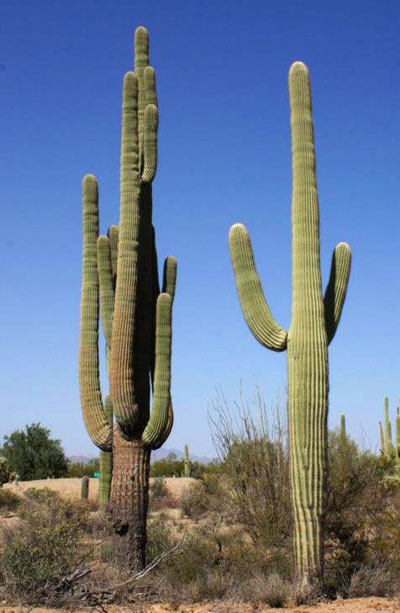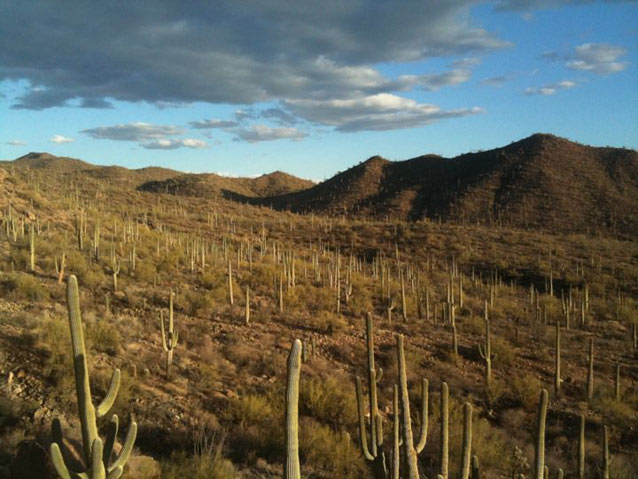Introduction

NPS
The saguaro cactus (Carnegia gigantea) is the signature species of Saguaro National Park. The park was established as a national monument in 1933 (it was raised to park status in 1994), specifically to protect an impressive stand of many large saguaros – the “Cactus Forest” – at the base of the Rincon Mountains east of Tucson, Arizona. However, concerns about the decline of the Cactus Forest have been expressed throughout the history of the park. As a result, research on saguaros in the park began as early as 1939 and continues to this day. Many studies have been published in scientific journals and provide great insight into the natural history of this charismatic desert plant.
The purpose of this project, supported primarily by the Western National Parks Association, the Friends of Saguaro National Park, and Desert Southwest Cooperative Ecosystem Studies Unit, was to combine the tools of historical and biological research to support the goal of long-term monitoring at the park. Specifically, park staff recognized that the datasets collected on saguaros over the years were valuable and irreplaceable cultural resources that have not only taught us much about the saguaro in the past, but could teach us even more in the future. An excellent summary of the results of saguaro studies at Saguaro National Park has been published (McAuliffe 1993), but research data and maps were scattered throughout the park or with outside researchers, and not accessible to park staff or future researchers. The goal of this project was to provide a guide to the history of saguaro research and monitoring that included maps of plot locations, a bibliography, and an archival component to ensure that these data would be preserved.
Methods
We used volunteers and student interns, in consultation with staff from the Western Archeological Conservation Center (WACC), to carefully evaluate materials from the park’s library, including some documents and maps that dated to the 1930s. Items identified as worthy of preservation were inventoried, copied, and archived at WACC. We used these items, materials in files in both districts of the park (the original Rincon Mountain District [RMD], as well as the Tucson Mountain District [TMD], which was added to the park in 1961), and interviews with saguaro researchers to compile a bibliography and narrative of saguaro research. Using computer-based mapping, we created maps of all known saguaro study plots in both districts, and developed a monitoring time-line for each set of plots. The final report for this project, “The History of Saguaro Monitoring at Saguaro National Park, 1939-2007” is available on-line.
Research on Saguaro Disease
Research on saguaros at Saguaro National Park can be divided into phases that have focused on disease, ecology, and longterm monitoring, although these are arbitrary categories with considerable overlap. At the beginning, the major research goal was to identify the causes of, and possible solutions to, observed deaths of large saguaros in the Cactus Forest. In 1941, U.S. Department of Agriculture (USDA) scientists Lake Gill and Paul Lightle mapped every saguaro in a mile-square section of the RMD and established a series of study plots to investigate a disease known as bacterial necrosis. In a largescale experiment, all unhealthy saguaros in one-half of the section were removed, dosed with pesticides and kerosene, and buried. In the other half of the section, diseased saguaros were allowed to remain. However, after ten years no difference was found between the two sites and the experiment was ended. Nevertheless, research on cactus diseases continued for decades and formed the basis of long-term monitoring.
Research on Saguaro Ecology

NPS
Beginning in the 1950s, as saguaros continued to decline, research shifted towards the plant’s life history and relationship with other plants, animals, and climate. Ecologists examined the relationship between young saguaros and “nurse plants” – trees and shrubs that protect young saguaros from trampling by animals and temperature extremes. Experimental and observational studies investigated relationships between seedlings and rodents, between flowers and their pollinators, and how animals use the plant for feeding and nesting. During the 1970s Charles Lowe and Warren Steenberg carried out detailed studies of the saguaro reproduction, recruitment, growth rates, and survival. Their results strongly indicated that the ultimate cause of many deaths of many saguaros was not disease but periodic freezes, which been suggested by Forrest Shreve as early as 1911. In more recent decades, scientists have also studied potential links between air quality and epidermal browning (a type of scaling) and the impacts of desert fires on saguaros.
Long-term Monitoring
During disease studies in 1941, the USDA established six 5-acre and six 10-acre study plots in the Cactus Forest. After the removal experiment ended, research continued on the 10-acre plots by Stanley Alcorn and, after 1979, his associate Tom Orum and Nancy Ferguson. These plots now have been surveyed every year since 1941 (with one exception, 1955), one of the longest annual monitoring project in any national park. The 5-acre monitoring plots have also been monitored since 1941, but more sporadically; they were re-surveyed in 1975 by Lowe and Steenberg, and in 2002 by Carianne Funicelli and Dale Turner. In the early 1960s Ray Turner and Rod Hastings established ten monitoring plots throughout the range of the saguaro, including two plots in Saguaro National Park, that provide an important regional framework for understanding the saguaro’s population dynamics. Finally, in 1990 the National Park Service established 45 additional plots, 25 in RMD and 20 in TMD; these plots were resurveyed in 2000 and are scheduled to be surveyed again in 2010.
Health of the Saguaro Population
More than 70 years of saguaro research and monitoring provide a remarkable and complex story of the dynamics of the saguaro cactus population at Saguaro National Park. In the RMD Cactus Forest, the data indicate that the number of adults declined from the 1930s to the 1960s, with few young saguaros surviving. Indeed, by 1962 some researchers were predicting that saguaros would be gone from the RMD by the year 2000.
However, researchers then began seeing increasing numbers of young saguaros. By 1990, monitoring on the 10-acre plots indicated that new recruits outnumbered members of the original population for the first time since 1942. Saguaros that first appeared in the 1960s are now approaching the height where visitors can see them at a distance. Based on current trends it appears that in the near future the Cactus Forest will again exhibit an abundance of large saguaros. Interestingly, the population in the TMD has remained relatively stable over the years.
What caused the decline in the Cactus Forest? Disease and air pollution are no longer believed to be major factors. Because freezes and drought kill young saguaros, long-term climatic cycles may influence the age and number of saguaros at any given location, and some scientists believe that saguaros were naturally in decline at the time of park establishment. However, heavy cattle grazing and wood-cutting in the RMD may have contributed to poor saguaro recruitment. Both activities reduce saguaro nurse plants, and examination of historic photos shows that trees and shrubs have dramatically increased at the park since the 1960s. Grazing, wood-cutting, and collecting of cacti are no longer allowed in the park, and there is thus some evidence that these policies have been successful at protecting the saguaro.
For the National Park Service, whose mission includes protecting natural and cultural resources for future generations, the knowledge gained from these studies may not be nearly as important as what they may teach us in the future. Saguaros live much longer than we do, possibly more than 200 years, although we do not yet know. If nothing else, seven decades of research at the park has taught us that managing saguaros requires a long-term perspective – one that can only be gained by delivering the knowledge of our predecessors to those who will follow us.
Literature Cited
McAuliffe, J. R. 1993. Case study of research, monitoring, and management programs associated with the saguaro cactus (Carnegiea gigantea) at Saguaro National Monument, Arizona. National Park Service Technical Report NPS/WRUA/NRTR-93/01. 50pp.
Project Contact
Don Swann
Saguaro National Park
3693 South Old Spanish Trail, Tucson, Arizona. 85730
Don_Swann@nps.gov
Prepared by Eric B. Ahnmark and Don E. Swann, Saguaro National Park, 2010.
Last updated: November 28, 2016
